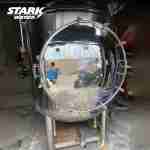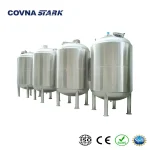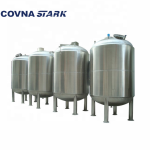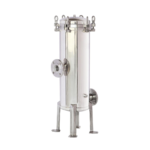In industrial water systems, not all tanks serve the same purpose. Some are designed to store water passively, while others are built to handle pressure and support active flow systems. Choosing the wrong type of tank can result in equipment failure, unstable flow rates, or unnecessary energy consumption.
This article breaks down the difference between holding tanks and pressure tanks, explains their key characteristics, and helps you determine which one best suits your industrial or commercial water application.
What Is a Holding Tank?
A holding tank—also known as a storage tank or buffer tank—is a non-pressurized vessel used to temporarily store water, chemicals, or process liquids at atmospheric pressure. These tanks act as reservoirs that supply downstream equipment or collect overflow and recycled water from upstream systems.
Key Features of Holding Tanks:
- Atmospheric design: Operates at 0 bar pressure, typically vented to air or fitted with a sterile breather valve.
- Flexible volume: Available in a wide range of sizes from 100 liters to 100,000+ liters depending on the application.
- Materials: Commonly made from SUS304/SUS316L stainless steel, FRP (fiberglass), or HDPE for chemical resistance.
- Bottom design: Conical or sloped bottoms help with drainage and sediment removal.
Holding tanks are widely used in RO feed systems, CIP loops, wastewater equalization, and ingredient storage. Their main role is to provide flow stability and buffer time for treatment or downstream demand fluctuations.
What Is a Pressure Tank?
A pressure tank—also known as a pressure vessel—is a sealed container designed to hold fluids under pressure. These tanks are used to stabilize system pressure, support constant water flow, or deliver water at specific pressure levels in pressurized piping networks.
Key Features of Pressure Tanks:
- Pressurized operation: Typically operates from 1 bar up to 10 bar or higher, depending on system design.
- Reinforced structure: Constructed to meet ASME, PED, or local pressure vessel codes to ensure safety under load.
- Air or nitrogen cushioning: Some pressure tanks (hydropneumatic) use a gas bladder to absorb pressure shocks and prevent pump cycling.
- Materials: Commonly made of carbon steel or stainless steel, with internal coatings or linings for corrosion protection.
Pressure tanks are found in booster pump systems, closed-loop circulation, fire suppression, and industrial dosing setups. Their role is to maintain flow rate, prevent water hammer, and avoid pump short-cycling by storing pressurized water or fluid.
Holding Tank vs Pressure Tank: Key Differences
While both tanks play important roles in water systems, they are designed for very different functions. Below is a comparison of the key differences to help you choose the right one for your process:
| Feature | Holding Tank | Pressure Tank |
|---|---|---|
| Operating Pressure | Atmospheric (0 bar) | Pressurized (1–10+ bar) |
| Main Function | Buffer, storage, equalization | Pressure stabilization, flow control |
| Common Applications | RO feed, wastewater, CIP return | Booster systems, dosing, fire water |
| Design Standards | No special code (unless for hygiene) | ASME / PED / GB pressure vessel codes |
| Material Options | SUS304/316L, FRP, PE, HDPE | Stainless steel, carbon steel, lined steel |
| Cleaning & Maintenance | Easy access, CIP-friendly | Requires depressurization and certified access |
Understanding these distinctions ensures you don’t install an underperforming tank in a pressurized system—or over-engineer a simple holding application. Selecting the correct tank type saves both upfront costs and long-term operational issues.
Which One Do You Need for Your Application?
Choosing between a holding tank and a pressure tank depends on your process requirements, flow conditions, and system layout. Below are some practical guidelines to help you make the right selection:
You Need a Holding Tank If You:
- Need to store treated water before further processing
- Have variable supply and want to buffer peak demand
- Operate at atmospheric pressure or feed RO/membrane systems
- Need easy cleaning and CIP access for hygienic processes
- Are dealing with wastewater equalization or overflow collection
You Need a Pressure Tank If You:
- Need to maintain constant system pressure downstream
- Operate closed-loop or pressurized piping systems
- Want to prevent pump short-cycling or water hammer
- Require rapid water delivery without activating pumps
- Are working with high-pressure equipment like dosing skids or fire suppression systems
In some industrial systems, both tank types are used together: a holding tank for stable feedwater storage, and a pressure tank downstream to regulate delivery pressure. The key is understanding the flow logic and designing the tank setup accordingly.
Conclusion: Match Your Tank Type to Your System Design
Holding tanks and pressure tanks serve very different—but equally essential—roles in industrial water treatment systems. Choosing the right one ensures process stability, equipment longevity, and proper flow dynamics. Misapplication, on the other hand, can lead to pump stress, contamination risks, and operational inefficiencies.
If you're unsure which tank suits your process—or how to integrate both types—our engineering team at STARK is here to help. We offer custom-designed stainless steel and FRP tanks for storage, pressure regulation, and complete system integration.
Need help choosing the right tank for your system?
Contact us today for expert consultation, tank sizing recommendations, and layout support.





